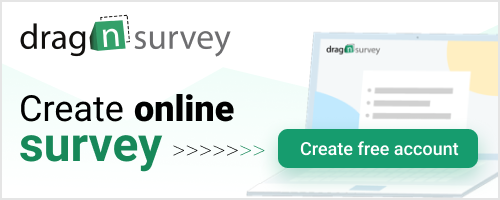Crafting open-ended questions in an online survey is a delicate art. It’s easy to fall into certain traps that can compromise the quality of the responses obtained. In this article, we’ll explore the most common mistakes to avoid when formulating questions, in order to ensure reliable and usable results.
>> Drag’n Survey, the solution to create an online survey, click here

The Importance of Clarity
Clarity is crucial when writing open-ended questions in an online survey. Poorly worded content can lead to poor quality results and erroneous conclusions.
Consequences of a Poorly Worded Open-Ended Question
An ambiguous or confusing open-ended question will likely lead respondents to interpret its meaning in different ways. This leads to varied responses that are difficult to analyze and compare. Additionally, participants may easily misunderstand what is expected of them and provide irrelevant or insufficiently detailed responses.
Best Practices for Clear and Precise Formulations
To ensure usable responses, open-ended questions must be formulated in a simple, direct, and unambiguous manner. They must clearly indicate the type of information sought from respondents. It is advisable to test them on a representative sample before launching the survey. Vague terms should be avoided as they lead to varied interpretations. Finally, somewhat restricting the scope of expected responses, while still allowing some leeway, allows for data that is more easily comparable and analyzable.
Avoiding Biased or Leading Open-Ended Questions
Biased or leading open-ended questions can influence respondents and skew the survey results. It is therefore essential to formulate them with neutrality and objectivity.
Recognizing Bias
A biased open-ended question subtly influences the respondent in favor of a particular response. It may contain assumptions, a value judgment, or steer towards a specific conclusion. It is important to be vigilant and verify that it truly allows for unbiased responses.
Techniques for Formulating Neutral Open-Ended Questions
To ensure neutrality, the question should not suggest any particular orientation or judgment. It is recommended to use a factual and objective wording, without emotionally charged terms. Testing open-ended questions on a diverse sample of respondents is an excellent way to detect any unintentional bias.

The Ideal Length
Length is a crucial aspect to consider when formulating an open-ended question. An appropriate length will allow respondents to clearly understand what is being asked of them, while encouraging usable and informative responses.
Finding the Right Balance
The goal of an open-ended question in a survey is to gather relevant and precise information. To do so, it must provide respondents with enough detail and context to guide them without being too long and complex.
The Dangers of Open-Ended Questions That Are Too Long or Too Short
If the content is too short or vague, respondents risk not understanding what is expected of them and providing low-quality responses. They may also feel frustrated if they do not have enough space to elaborate their response.
Conversely, an open-ended question that is too long and detailed may deter the participant by requiring too high a level of involvement. Responses will then be fewer and too dispersed to allow for productive analysis.
The length must therefore be adapted to the desired content, neither too short nor too detailed, in order to strike a balance between precision and conciseness.

The Importance of Relevance
Relevance is a crucial aspect when formulating open-ended questions in an online survey. Content that is not relevant to the survey’s objectives is not only useless, but can also skew the results and analyses.
Before drafting an open-ended question, it is essential to ensure that it will indeed obtain information that is aligned with the intended purpose. To do so, several steps are recommended.
How to Ensure Relevance?
First, it must be in perfect coherence with the overall theme of the survey. It should then provide details on a particular aspect that is the subject of analysis. It is important to verify that the expected qualitative data is indeed useful in addressing the issue at hand. A good way is to ask oneself whether concrete insights can be drawn from the responses provided.
Avoid Off-Topic Open-Ended Questions
Open-ended questions unrelated to the survey’s objectives should be avoided entirely. Not only will they provide unusable data, but they can also distract and confuse the respondent. A good practice is to carefully reread the survey, constantly keeping the research issue in mind to identify any off-topic open-ended questions.

How to Analyze the Responses?
Effective data analysis is essential. A few best practices can greatly facilitate this task.
The analysis of open-ended questions begins with their formulation. Indeed, well-structured open-ended questions determine the quality of the responses obtained and their usability.
Preparing the Analysis During Formulation
To effectively prepare the analysis, the questions should focus on specific aspects of the topic being addressed. They should clearly indicate the type of qualitative information sought. Overly vague open-ended questions will yield data that is difficult to compare. Conversely, if they are too closed-ended, they will limit respondents’ expression. A balance must be found.
Tools and Techniques for Effective Analysis
Several tools and methods allow for processing and interpreting responses. Text analysis, categorization, and visual exploration of textual data are among the techniques frequently used. Qualitative data analysis software like Drag’n Survey also facilitate the coding and statistical processing of responses. Regardless of the approach, the objective is to extract a maximum amount of relevant information from this qualitative data.
More about surveys:
The Finest Software for Online Survey Construction, click here
The Finest Software Options for Online Quiz Making, click here
Essential Tools for Crafting a Customer Satisfaction Survey, click here
The Role of Customer Satisfaction Score (CSAT) in Business, click here
14 Must-Ask Questions for Your Customer Feedback Survey, click here
The Net Promoter Score (NPS) as a Customer Loyalty Metric, click here
The Essential Indicators for Measuring Customer Satisfaction, click here
7 Recommended JotForm Replacements for Online Form Makers, click here
The Top 5 Indispensable Typeform Alternatives for Form Building, click here
The 6 Foremost Alternatives to Google Forms for Form Customization, click here
The Unique Characteristics of Qualitative and Quantitative Research Methods, click here
The Top 5 Picks for SurveyMonkey Alternatives in Online Questionnaire Making, click here
Read the article:
Portuguese – Erros a evitar ao formular perguntas abertas, click here
Polish – Błędy do uniknięcia podczas formułowania pytań otwartych, click here
French – Les erreurs à éviter lors de la formulation de questions ouvertes, click here
German – Die Fehler, die man bei der Formulierung von offenen Fragen vermeiden sollte, click here
